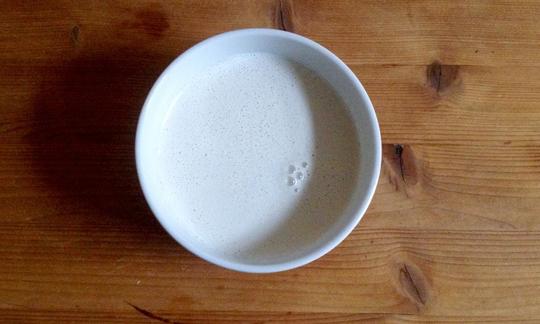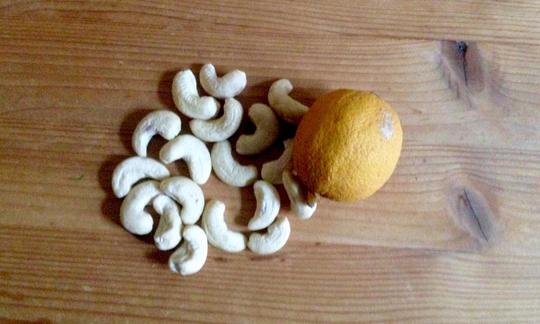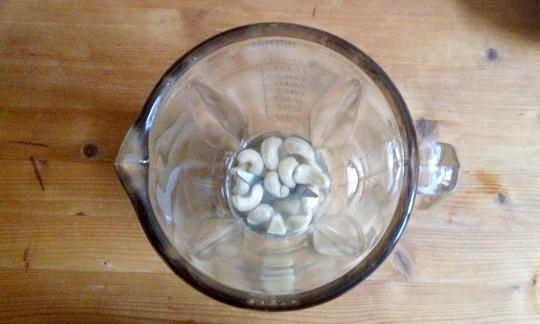Cashew Yogurt Is Vegan but Seldom Raw!
raw-vegan
Ingredients (for serving, )
| 2 ⅛ oz | Cashew nuts, raw? organic? (cashew nuts) |
| 80 ml | Drinking water, raw (organic?) (2.8 oz) |
| ⅛ | Lemons, raw (limes, organic?) (0.25 oz) |
Equipment
- blender or hand-held blender / immersion blender
Type of preparation
- soak
- blend
- strain
- season to taste
Preparation
Place the cashews in a bowl, cover with fresh water, and soak for at least four hours.
If you are pressed for time, you can skip this step. However, soaking nuts increases the nutritional benefits (see “Notes about recipe” below) and ensures that the yogurt has a creamy consistency.
Pour the cashews into a sieve and rinse briefly. Then add to a blender along with 80 ml of water.
A high-powered blender works best here.
Blend on the highest setting until you have a smooth cream.
This process can take several minutes and might require you to use a spatula to scrape down the sides so that all of the little pieces of cashews get blended in.
Add a few dashes of lemon juice to the cashew yogurt and then serve.
|
Nutritional Information per person
Convert per 100g
|
2000 kcal | |
|---|---|---|
| Energy | 334 kcal | 16.7% |
| Fat/Lipids | 26 g | 37.6% |
| Saturated Fats | 4.7 g | 23.4% |
| Carbohydrates (inc.dietary fiber) | 19 g | 7.0% |
| Sugars | 3.7 g | 4.1% |
| Fiber | 2.2 g | 8.7% |
| Protein/Albumin | 11 g | 22.0% |
| Cooking Salt (Na:10.5 mg) | 27 mg | 1.1% |
| Essential micronutrients with the highest proportions | per person | 2000 kcal | |
|---|---|---|---|
| Min | Copper, Cu | 1.3 mg | 133.0% |
| Prot | Tryptophan (Trp, W) | 0.17 g | 69.0% |
| Elem | Phosphorus, P | 357 mg | 51.0% |
| Min | Manganese, Mn | 1.00 mg | 50.0% |
| Elem | Magnesium, Mg | 177 mg | 47.0% |
| Fat | Linoleic acid; LA; 18:2 omega-6 | 4.7 g | 47.0% |
| Prot | Threonine (Thr, T, irreversibly transaminated) | 0.41 g | 44.0% |
| Prot | Valin (Val, V) | 0.66 g | 41.0% |
| Prot | Isoleucine (Ile, I) | 0.47 g | 38.0% |
| Prot | Leucine (Leu, L) | 0.88 g | 37.0% |
Detailed Nutritional Information per Person for this Recipe
The majority of the nutritional information comes from the USDA (US Department of Agriculture). This means that the information for natural products is often incomplete or only given within broader categories, whereas in most cases products made from these have more complete information displayed.
If we take flaxseed, for example, the important essential amino acid ALA (omega-3) is only included in an overarching category whereas for flaxseed oil ALA is listed specifically. In time, we will be able to change this, but it will require a lot of work. An “i” appears behind ingredients that have been adjusted and an explanation appears when you hover over this symbol.
For Erb Muesli, the original calculations resulted in 48 % of the daily requirement of ALA — but with the correction, we see that the muesli actually covers >100 % of the necessary recommendation for the omega-3 fatty acid ALA. Our goal is to eventually be able to compare the nutritional value of our recipes with those that are used in conventional western lifestyles.
| Essential fatty acids | per person | 2000 kcal |
|---|---|---|
| Linoleic acid; LA; 18:2 omega-6 | 4.7 g | 47.0% |
| Alpha-Linolenic acid; ALA; 18:3 omega-3 | 0.04 g | 2.0% |
| Essential amino acids | per person | 2000 kcal |
|---|---|---|
| Tryptophan (Trp, W) | 0.17 g | 69.0% |
| Threonine (Thr, T, irreversibly transaminated) | 0.41 g | 44.0% |
| Valin (Val, V) | 0.66 g | 41.0% |
| Isoleucine (Ile, I) | 0.47 g | 38.0% |
| Leucine (Leu, L) | 0.88 g | 37.0% |
| Phenylalanine (Phe, F) | 0.57 g | 37.0% |
| Lysine (Lys, K, irreversibly transaminated) | 0.56 g | 30.0% |
| Methionine (Met, M) | 0.22 g | 23.0% |
| Vitamins | per person | 2000 kcal |
|---|---|---|
| Vitamin K | 20 µg | 27.0% |
| Vitamin B1 (Thiamine) | 0.26 mg | 23.0% |
| Vitamin B6 (pyridoxine) | 0.26 mg | 18.0% |
| Vitamin B7 (Biotin, ex vitamin H) | 6.9 µg | 14.0% |
| Vitamin B5 (Pantothenic acid) | 0.53 mg | 9.0% |
| Vitamin B9, B11 (Folate, as the active form of folic acid) | 16 µg | 8.0% |
| Vitamin C (ascorbic acid) | 4.1 mg | 5.0% |
| Vitamin E, as a-TEs | 0.55 mg | 5.0% |
| Vitamin B3 (Niacin) | 0.64 mg | 4.0% |
| Vitamin B2 (Riboflavin) | 0.04 mg | 3.0% |
| Vitamin A, as RAE | 0.07 µg | < 0.1% |
| Essential macroelements (macronutrients) | per person | 2000 kcal |
|---|---|---|
| Phosphorus, P | 357 mg | 51.0% |
| Magnesium, Mg | 177 mg | 47.0% |
| Potassium, K | 406 mg | 20.0% |
| Calcium, Ca | 26 mg | 3.0% |
| Sodium, Na | 11 mg | 1.0% |
| Essential trace elements (micronutrients) | per person | 2000 kcal |
|---|---|---|
| Copper, Cu | 1.3 mg | 133.0% |
| Manganese, Mn | 1.00 mg | 50.0% |
| Zinc, Zn | 3.5 mg | 35.0% |
| Iron, Fe | 4.1 mg | 29.0% |
| Selenium, Se | 12 µg | 22.0% |
| Fluorine, F | 57 µg | 2.0% |
| Iod, I (Jod, J) | 3.1 µg | 2.0% |
This cream made from cashews is similar to yogurt and can be used as a base recipe for a number of sweet and savory variations. Cashew yogurt is seldom raw.
Alternatives to yogurt: Traditionally, yogurt is a slightly sour fermented dairy product. When it comes to a creamy consistency, this vegan version made with cashews is in no way inferior to the original. And it is rich in the essential amino acid tryptophan. There are now numerous types of vegan yogurts available — most of which are soy — but they are usually highly processed and contain many additives such as stabilizers and coloring agents as well as sugar. However, like the original dairy yogurt, these products are usually fermented.
Yogurt cultures: Thanks to the acidification of the lemon juice, this recipe for cashew yogurt just imitates fermentation, but it is a simpler and quicker option. However, if you like to experiment and have time, you can replace the lemon juice with yogurt cultures. These can be purchased ready to use.
Cashews are seldom raw: Cashews almost always undergo a heating process even if “Raw Cashews” is on the label. This usually just means that the toxic cardol they contain has been deactivated by steaming instead of roasting. It is only when the process is explained in detail and controlled that we can be sure the cashews are raw.
Cooling: If you want an even fresher taste, place in the refrigerator before serving.
Possible uses: This cashew yogurt works well as a base for fruit salad or muesli. It is also a nice side dish for hearty dishes. If desired, you can make a flavored version by adding some vanilla.
Consistency: The amount of water you use determines the consistency — if you add more water, you can achieve a consistency similar to cream. It can be used to add a finishing touch to sauces, soups, and dressings. Using the lemon is then optional.








